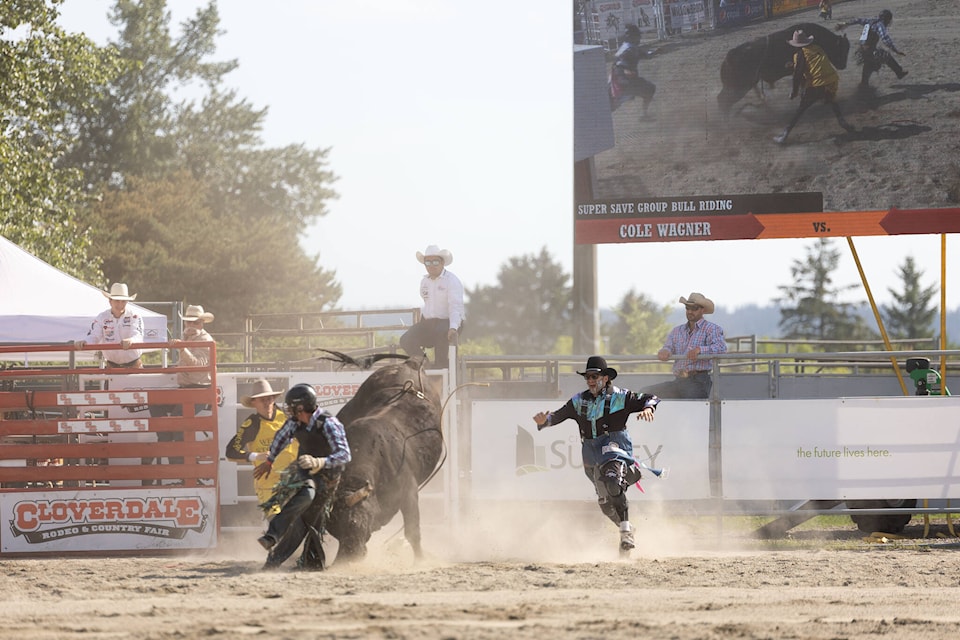Canada’s second largest rodeo is around the corner.
The Cloverdale Rodeo will enjoy its 76th iteration on May long weekend (May 17 - 20) this year.
The 133rd incarnation of the County Fair is back too and with all the surrounding events, exhibitions, entertainment, and attractions, it’s sometimes hard to remember there is still a rodeo to be had with more than $300,000 in prize money to be given out.
In past years, the Rodeo and Country Fair has seen crowds north of 100,000 over the four-days of “Rodeo Weekend.”
With that many people descending on the Cloverdale Fairgrounds, it’s safe to say there are more than a few rodeo-goers that could brush up on the finer points of the sport.
As such, the Cloverdale Reporter is offering its “Four Bs of Rodeo” to enhance the rodeo knowledge of even the greenest of cowpokes.
The Cloverdale Rodeo is an invitational “roughstock” rodeo. It no longer has roping events, and is not sanctioned by the Canadian Professional Rodeo Association—the governing body of professional rodeo in Canada. As such, the athletes are competing for cash only. It’s known as a “jackpot rodeo” and the competitors do not get points towards qualification for the Canadian Finals Rodeo.
Instead, Cloverdale features only three roughstock events: bull riding, saddle bronc riding, and bareback riding. The rodeo also features barrel racing, which is called a timed event.
In roughstock events, both rider and animal can score up to 50 points each for a score out of 100. They are also trying to stay on the animals for—what can be a very long—eight seconds.
BULL
The first B is, perhaps, the biggest most well-known B of all. And rightly so, bulls can weigh, literally, a tonne. Bull riding is widely acknowledged as “the most dangerous eight seconds in sports.”
Bull riders have to stay on the beast for those eight thousand milliseconds, attempting to ride in the middle of the bucking bull without getting whipped to the side, or under, the 2000-pound-plus behemoth.
Bull riders try to stay upright without swaying back and forth or falling over. The rider is also awarded points for how he holds his free arm and for his spurring action, if able to spur, which can earn him extra points.
As mentioned, half of a bull rider’s score will be based on how hard the bull bucks and the other half on the cowboy’s ride. A cowboy is disqualified if he uses his free hand to help himself stay upright, such as touching the bull, his own body, or the flat braided rope.
And perhaps the most important thing for both cowpokes and fans to know: a bull ride is never over until the cowboy is safely back on the other side of the fence.
BRONC
The second B is for Bronc, saddle bronc riding that is. And saddle bronc is all about timing and control.
The bronc rider must synchronize his every move with the horse. A cowboy tries to give a smooth ride while holding a single thick-braided rein with one hand. The more control and fluidity to his actions, the greater points he’ll garner. So his spurring action should be timed with the horse as it bucks over his attempt at an eight-second ride.
Spurring action is vital to score points. If a cowboy has great spurring action, his feet will extend forward past the horse’s shoulder and he’ll snap them back in sync with the horse’s bucking motion.
The “markout rule” is in effect for saddle bronc riding. That means a cowboy’s spurs must be touching the horse above the point of the horse’s shoulders on the first jump when the horse pops out of the bucking chute. If not the cowboy will receive a no score.
BAREBACK
The third B to know is: bareback. Bareback riding is similar to saddle bronc, but where saddle bronc resembles poetry on horseback, bareback is as wild as the Old West.
In bareback a rider holds a rigging, which can be described as a small suitcase handle, and attempts to hold on for, again, eight seconds.
The event can be summed up in three words: timing, timing, timing. A cowboys feet must be back at the horse’s shoulders before the horse’s front hooves hit the rodeo bowl’s dirt. If he can do this amongst the frenetic bucking and bounding, he’ll earn top points. Easier written than done.
Again, if the rider uses his free hand to steady himself, he’ll get a “no score.”
The mandatory markout rule is also in effect for bareback too. That means a cowboy’s spurs must be touching the horse above the point of the shoulders on the first jump when the horse bounds out of the chute. If not, the cowboy will be disqualified.
BARREL
Last, but certainly not least, is B for barrel. Barrel racing is not a roughstock event, but a timed event. The fastest time wins, it’s that simple.
Both boys and girls participate in barrel racing as a kids’ sport, but as a college and professional sport, it’s exclusively a women’s event.
Cowgirls will start in the alleyway and build up speed as they enter the rodeo arena. Three barrels are set out in a triangle pattern and racers can go left or right, it’s up to them, but they must race in a cloverleaf pattern.
A rider may tip or touch a barrel, but if it falls over, that results in a five-second penalty. Because the speeds are so fast and the races very close, a barrel penalty, therefore, will eliminate a rider from competition.
